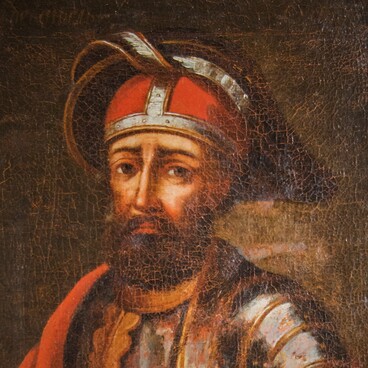The portrait of the first Russian emperor Peter the Great was made by an unknown artist in the late 18th — early 19th century.
The portrait is painted in the manner of parsuna. Parsuna is an early genre of a secular portrait of the 17th一18th centuries, which was similar in many ways to icons. The word ‘parsuna’ is derived from Latin ‘persona’, which means ‘person’.
The State Museum Fund donated the portrait to the Omsk Museum of History and Regional Studies in 1928. The paint layer was damaged, as the canvas had been stored twisted for a long time. In 1933, the portrait was restored in the workshop of the Omsk Regional Museum of Fine Arts named after M. A. Vrubel. The specialists reconstructed the canvas stretcher, filled in the painting fragments, relined the canvas, that is reinforced the painting base.
Peter the Great ascended the throne after the death of the tsar Feodor Alekseyevich in 1682, but he was a ‘younger tsar’ during the reign of his sister Sophia. For a long time, Peter lived in the village of Preobrazhenskoye near Moscow, where he formed his ‘toy army’ — the future Imperial Guard. In August 1689, Peter heard that Sophia was preparing a palace revolution and went to the Trinity monastery where his loyal troops also came. The armed forces of nobles surrounded Moscow and confined Sophia in the Novodevichy Convent.
In 1703, Peter founded the city of Saint Petersburg, which became the state capital in 1712. In 1721, Russia was declared an empire. Peter introduced significant reforms in all spheres of life. He was the first of Russian rulers to take the best ideas from western countries. By the order of Peter the Great, books, instruments, weapons were bought abroad, foreign masters and scientists were invited. He met with Gottfried Leibniz and Isaac Newton, and in 1717 was elected an honorary member of the French Academy of Sciences.
The emperor uplifted the economy, established a network of steel and glass factories, and minimized the import of foreign goods. Peter the Great initiated large-scale construction of ships, and young nobles started to learn shipbuilding abroad. One of the main achievements of the emperor was the expansion of Russia’s territories in the Baltic region after the victory in the Great Northern War.
The portrait is painted in the manner of parsuna. Parsuna is an early genre of a secular portrait of the 17th一18th centuries, which was similar in many ways to icons. The word ‘parsuna’ is derived from Latin ‘persona’, which means ‘person’.
The State Museum Fund donated the portrait to the Omsk Museum of History and Regional Studies in 1928. The paint layer was damaged, as the canvas had been stored twisted for a long time. In 1933, the portrait was restored in the workshop of the Omsk Regional Museum of Fine Arts named after M. A. Vrubel. The specialists reconstructed the canvas stretcher, filled in the painting fragments, relined the canvas, that is reinforced the painting base.
Peter the Great ascended the throne after the death of the tsar Feodor Alekseyevich in 1682, but he was a ‘younger tsar’ during the reign of his sister Sophia. For a long time, Peter lived in the village of Preobrazhenskoye near Moscow, where he formed his ‘toy army’ — the future Imperial Guard. In August 1689, Peter heard that Sophia was preparing a palace revolution and went to the Trinity monastery where his loyal troops also came. The armed forces of nobles surrounded Moscow and confined Sophia in the Novodevichy Convent.
In 1703, Peter founded the city of Saint Petersburg, which became the state capital in 1712. In 1721, Russia was declared an empire. Peter introduced significant reforms in all spheres of life. He was the first of Russian rulers to take the best ideas from western countries. By the order of Peter the Great, books, instruments, weapons were bought abroad, foreign masters and scientists were invited. He met with Gottfried Leibniz and Isaac Newton, and in 1717 was elected an honorary member of the French Academy of Sciences.
The emperor uplifted the economy, established a network of steel and glass factories, and minimized the import of foreign goods. Peter the Great initiated large-scale construction of ships, and young nobles started to learn shipbuilding abroad. One of the main achievements of the emperor was the expansion of Russia’s territories in the Baltic region after the victory in the Great Northern War.



